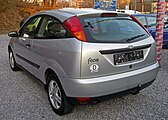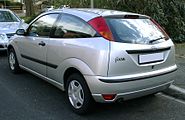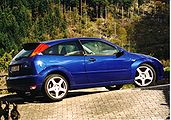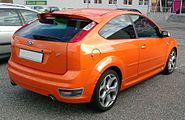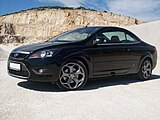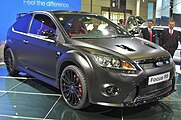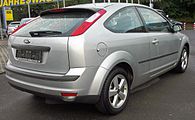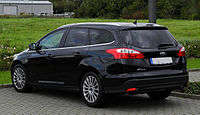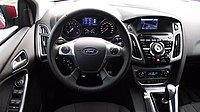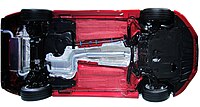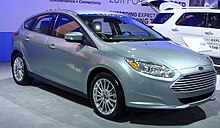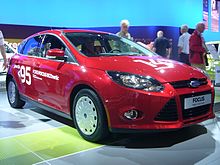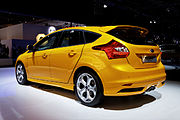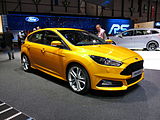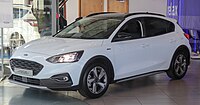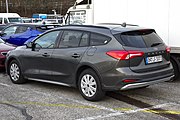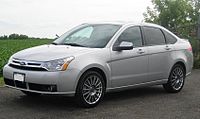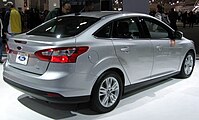Ford Focus
| Ford Focus | |
|---|---|
| Production period: | since 1998 |
| Class : | Compact class |
| Body versions : | Hatchback , sedan , station wagon , convertible |
| Previous model: |
Ford Escort Ford Escort (United States) Ford Laser Ford Orion |
The Ford Focus is a car -Modellreihe the car manufacturer Ford in the compact class . It was launched in Europe in autumn 1998, in North and South America in spring 2000 and in Australia in September 2002.
In most countries it was the successor to the Ford Escort , in Asia and Australia it replaced the Ford Laser . In April 2011, the third generation of the compact car was launched in Europe, the USA and Asia. A facelift was made in 2014.
In the years 2012 to 2014, the Ford Focus again reached first place in the global sales statistics, with more than one million units sold each time.
Focus '98 (1998-2004)
| 1st generation | |
|---|---|
|
Ford Focus Notchback (1999-2001) |
|
| Production period: | 1998-2004 |
| Body versions : | Station wagon , sedan , station wagon |
| Engines: |
Otto engines : 1.4–2.0 liters (55–158 kW) Diesel engines : 1.8 liters (55–85 kW) |
| Length: | 4150-4465 mm |
| Width: | 1702 mm |
| Height: | 1440-1491 mm |
| Wheelbase : | 2615 mm |
| Empty weight : | 1125-1390 kg |
The Ford Focus was developed by Ford of Europe and was launched in Europe in October 1998. From spring 2000 it was also offered in North America; there, too, he sold well.
The vehicle was designed as a three- and five-door hatchback model (model codes: DBW or DAW) and was available with three different gasoline engines for market launch. In February 1999, the four-door notchback variant (code: DFW), which was manufactured for Europe in Almussafes near Valencia (Spain), as well as the combination variant tournament (code: DNW) came onto the German market.
The Focus differed from the competition models, among other things, by the New Edge design that Ford had first introduced with the Ka in autumn 1996 . In addition, the Focus had a complex independent suspension for the rear wheels, which was unique in the compact car class at the time .
The standard equipment of the vehicles in Germany included four airbags, ABS and electric window lifters (front) and a traction control system for the more powerful engines . The list of surcharges included further details such as air conditioning , on-board computer , cruise control , seat heating and later ESP .
From February 1999 the Focus was also available with a TDDi diesel engine with a displacement of 1.8 liters and an output of 66 kW. From August 1999 there was also another 1.8-liter diesel with 55 kW.
Facelift
| Stars in the Euro NCAP - Crash Test |
|
In 2000 and 2001, the Ford Focus was the world's best-selling car. In October 2001, as part of a facelift , the Ford Focus received new headlights with integrated indicators and separate high and low beam, modified bumpers and some modified details in the interior (such as the center tunnel) and in the electrical system (such as the installation of a General Electric in particular Module similar to other Ford models). The tournament combination model was only available with a roof rail .
Two new engines were introduced, for example a 2.0-liter gasoline engine with a power of 127 kW (173 hp) installed from January 2002 in the top model ST 170 ( ST for Sports Technology ). This model had a six-speed gearbox, dark recessed headlights, a larger brake system and sports suspension . It also had special sports seats, also from Recaro on request . With the facelift, bi- xenon light was available, as was automatic air conditioning. From November 2002 the Focus was also offered as a natural gas vehicle with underfloor tanks.
In October 2002 the Focus RS was presented, whose two-liter turbo engine developed 158 kW (215 PS). It was equipped with numerous racing components, including 18-inch Oz rims, Brembo brakes, Quaife limited-slip differential, Sparco half-shell seats , a Getrag sports transmission and an AP racing clutch, as well as the look of the Ford Focus WRC rally car . The production of the Focus RS was limited to 4501 copies worldwide and only available in the color Imperial Blue (also called Ford Racing Blue). In addition, the respective serial number was stamped on the center console. In November 2003 the production of the Focus RS was finished.
The Focus was offered in four equipment variants: in an economy version without a name (colloquially basic Focus, among other things without central locking and without electric windows), in the basic equipment ambience , in the sport version Trend and in the luxury version Ghia . There were also various special models such as Viva , Viva X , Futura , Finesse , Sport TDCi and the luxury versions Ghia X and Ghia Exclusiv .
In June 2005, the 10 millionth compact class car was produced in the Saarlouis pilot plant (Focus and its predecessor, the Escort).
Technical specifications
| 1.4 | 1.6 | 1.8 | 2.0 | 2.0 ST 170 | 2.0 RS | 1.8 TDDi | 1.8 TDCi | |||
|---|---|---|---|---|---|---|---|---|---|---|
| Construction period | 08 / 1998-08 / 2004 | 01 / 2002-08 / 2004 | 10 / 2002–11 / 2003 | 08 / 1999-08 / 2004 | 02 / 1999-08 / 2004 | 08 / 2002-08 / 2004 | 01 / 2001-08 / 2004 | |||
| Engine characteristics | ||||||||||
| Engine identification | FXDA, FXDC, FXDB, FXDD | FYDA, FYDC, FYDB, FYDD, FYDH | EYDC, EYDB, EYDD, EYDE, EYDG, EYDI, EYDJ, EYDL | EDDC, EDDB, EDDD, EDDF | ALDA | HMDA | BHDA, BHDB | C9DC, C9DA, C9DB | FFDA | F9DA, F9DB |
| Engine type | Zetec-S | Zetec-E | R4 diesel engine | |||||||
| Number of valves per cylinder | 4th | 2 | ||||||||
| Valve control | DOHC , timing belt | OHC, timing belt | ||||||||
| Mixture preparation | Manifold injection | Direct injection | Common rail injection | |||||||
| Engine charging | - | Turbocharger , intercooler | ||||||||
| cooling | Water cooling | |||||||||
| Bore × stroke | 76.0 mm × 76.5 mm | 79.0 mm × 81.4 mm | 80.6 mm × 88.0 mm | 84.8 mm x 88.0 mm | 82.5 mm × 82.0 mm | |||||
| Displacement | 1388 cc | 1596 cc | 1796 cc | 1988 cc | 1753 cc | |||||
| Compression ratio | 11.0: 1 | 10.0: 1 | 10.2: 1 | 8.0: 1 | 19.4: 1 | 18.5: 1 | ||||
| Max. Power at min −1 |
55 kW (75 PS) / 5000 |
74 kW (100 PS) / 6000 |
85 kW (115 PS) / 5500 |
96 kW (130 PS) / 5500 |
127 kW (173 PS) / 7000 |
158 kW (215 PS) / 5500 |
55 kW (75 PS) / 4000 |
66 kW (90 PS) / 4000 |
74 kW (100 PS) / 3850 |
85 kW (115 PS) / 3800 |
| Max. Torque in min -1 | 123 Nm / 3500 |
145 Nm / 4000 |
160 Nm / 4400 |
178 Nm / 4500 |
196 Nm / 5500 |
310 Nm / 3500 |
175 Nm / 1800 |
200 Nm / 2000 |
240 Nm / 1750 |
250 Nm / 1850 |
| Power transmission | ||||||||||
| drive | Front wheel drive | |||||||||
| Gearbox, as standard | 5-speed manual transmission | 6-speed manual transmission | 5-speed manual transmission | |||||||
| Gearbox, optional | - | 4- speed automatic transmission | - | 4-speed automatic transmission | - | |||||
| Readings | ||||||||||
| Top speed | 171 km / h | 173-185 km / h | 198 km / h | 197–201 km / h | 216 km / h | 232 km / h | 167 km / h | 180 km / h | 186 km / h | 196 km / h |
| Acceleration, 0-100 km / h | 15.1-15.5 s | 10.3-12.1 s | 10.2-10.6 s | 9.2-9.6 s | 8.2 s | 6.7 s | 14.7 s | 12.4-12.9 s | 11.6-11.7 s | 10.6-10.7 s |
| Fuel consumption over 100 km (combined) | 6.6 l p | 6.8-7.8 l S | 7.5-7.6 l S | 8.5-9.4 s | 9.1 l SP | 10.1 l SP | 5.1 l D | 5.4 l D | ||
| Empty weight | 1149 kg | 1152 kg (1186 kg) | 1200 kg | 1221 kg | 1221 kg | 1280 kg | 1283 kg | 1258 kg | 1279 kg | 1279 kg |
- The curb weight refers to the three-door model.
- The availability of the engines depended on the model, equipment and market.
Model overview
Focus '04 (2004-2010)
| 2nd generation | |
|---|---|
|
Ford Focus five-door (2004-2007) |
|
| Production period: | 2004-2010 |
| Body versions : | Hatchback , sedan , station wagon , convertible |
| Engines: |
Petrol engines : 1.4–2.5 liters (59–257 kW) Diesel engines : 1.6–2.0 liters (66–100 kW) |
| Length: | 4342-4509 mm |
| Width: | 1834-1840 mm |
| Height: | 1409-1501 mm |
| Wheelbase : | 2640 mm |
| Empty weight : | 1227-1437 kg |
In November 2004 the second model generation of the Ford Focus (code: DA3) was introduced. It was based on the floor pan of the compact van Ford Focus C-MAX, which had been in production since mid-May 2003 . The notchback and the wagon version tournament followed in February 2005.
Visually, the second model generation differed from its predecessor in particular in the visible size difference and the significantly flatter rear window.
The Ford Focus FFV (FFV = Flexible Fuel Vehicle ) used ethanol as fuel. The fuel system has been slightly modified for this purpose. Gasoline and ethanol could be filled into the same tank in any mixing ratio.
Equipment variants
Initially, the following equipment was available: Ambiente (basic model), Trend , Sport , Ghia and Titanium . There were also the edition models Fun , Style and Connection .
From July 2006 two new edition models were offered: the Focus Fun X and the Focus Sport TDCi . In return, the Sport trim level was discontinued. In spring 2007, the Style edition model replaced the Fun X.
From 2008 the edition models Black / Silver Magic, Sport and Rallye were available, from 2009 the models Sport and Black / Silver / White Magic were also available with diesel engines (1.6 TDCi).
Safety equipment
In addition to the usual ABS and belt tensioners, the Ford Focus had an electronic brake assistant (EBA), ESP with ASR and a total of 6 airbags (driver / front passenger, two side airbags and head-shoulder airbags at the front and rear) as standard. He received the Euro NCAP - Crash Test five out of five stars.
| Stars in the Euro NCAP - Crash Test |
|
Facelift
In November 2007, the Focus series was visually revised as part of a facelift. The market launch took place on February 23, 2008.
From this point in time, a dual clutch transmission called Powershift was available (only for diesel engines with a displacement of 2.0 liters) and, in conjunction with xenon light , LED rear lights were also available. Both taillights are brightly colored. In the interior there was a new instrument cluster with the more modern on-board computer known from the Ford S-MAX .
The model variant ECOnetic was also offered as a five-door and as a tournament. The consumption of the 80 kW (109 PS) TDCi engine ( common rail diesel) could be reduced to 4.3 l / 100 km thanks to an improved engine management system, smooth running tires, special gear oil, sports suspension and modified aprons .
In March 2010, the notchback version was taken out of the range due to recently low demand. In November 2010, production of the entire second Focus series finally ended.
Focus ST
In September 2005, the Focus ST came onto the market as a sporty top model , which was equipped with a turbocharged 2.5-liter five-cylinder in-line engine with 166 kW (225 hp).
For the Focus ST , numerous parts were contributed by sister company Volvo , for example the brake system and the engine, which was used there in the C30 , S40 / V50 , V70 and C70 models . The Focus ST was the only Ford to be available in the special metallic paintwork Electric Orange for an extra charge ; around 30 percent of all vehicles ordered in Europe were ordered in this paintwork. In contrast to its predecessor, this Focus ST was not available as a tournament.
Like the other Focus variants, the Focus ST received a facelift in November 2007. Production was stopped in late summer 2010.
Focus CC
In March 2007 Ford introduced a convertible version of the Focus under the name Focus CC (Coupé-Cabriolet) , which was assembled by the Pininfarina company in Turin ( Italy ).
It was the first Ford convertible in Europe with a folding hardtop . The steel roof could be opened or closed within 29 seconds. The car was equipped with the 1.6-liter gasoline engine with 74 kW (101 hp), the 2.0-liter gasoline engine with 107 kW (145 hp) and the 2.0-liter diesel engine with 100 kW (136 hp ) offered.
The coupé-convertible was visually and technically revised shortly after the other Focus models in April 2008.
In July 2010 the production of the Focus CC was stopped.
Focus C-MAX
The first model generation of the compact van (internal C214 ), which was produced in the Ford factory in Saarlouis, was produced from mid-May 2003 and formed the basis for the second generation of the Ford Focus. After a revision in spring 2007, the vehicle was only called Ford C-MAX.
Focus SUV
Another niche model is the compact SUV Ford Kuga based on the Focus, the first generation of which was manufactured from February 2008 to October 2012.
Focus X-Road
In April 2009, Ford presented a vehicle called the Focus X-Road at the AutoRAI in Amsterdam, based on the Focus “Titanium” tournament and equipped with an off -road appearance and slightly increased ground clearance .
However, this variant was officially only available in the Netherlands and only with the 1.8 liter unit as a flexifuel (petrol can be mixed with ethanol). The hallmarks of the X-Road are wide fenders, rocker panels and apron panels, silver-painted 17 "alloy wheels and a front with a wide air inlet and additional headlights.
Only around 300 vehicles of the Focus X-Road were produced from July 2009 to November 2010, which makes it a very rare example on the streets.
Focus RS
On July 22, 2008, Ford presented the production version of the Focus RS for the first time at the London International Motor Show , production of which began in January 2009.
Outwardly, the Focus RS , which is only available as a three-door model , differed significantly from the other Focus models: The fenders were widened to accommodate the large 19-inch wheels with 235 tires along with the wider track. The front and rear aprons were completely redesigned. The diffuser and a large rear wing increased the downforce on the rear axle.
The Focus RS was based on the sporty ST model variant and, with a base price of 33,900 euros, was well below the prices of the competing models Audi S3 , BMW 130i and VW Golf R32 when it was launched .
The bucket seats specially developed for the car offered plenty of lateral support and good back support. The Focus RS also had additional instruments and a speedometer that reached up to 280 km / h.
The 2.5-liter turbo five-cylinder already used in the Focus ST has been revised and equipped with a reworked cylinder head with optimized camshafts, a larger BorgWarner "K16" turbocharger with higher boost pressure, a larger intercooler and new engine management. The power increased to 224 kW (305 hp) at 6500 rpm, the maximum torque was 440 Nm at 2300 to 5500 rpm.
The Focus RS was equipped as standard with a new type of front axle construction ("Revo-Knuckles"). This reduced the forces on the MacPherson strut. In addition, a mechanical limited slip differential "Automatic-Torque-Biasing" from the manufacturer Quaife with six planetary gears was installed.
The acceleration from 0 to 100 km / h was specified by the manufacturer with 5.9 seconds and the top speed with 263 km / h. The car magazine sport auto measured a copy in the summer of 2010 with 6.1 seconds, in another test in 2009 a car only managed this in 6.4 seconds.
As the fastest front-wheel drive vehicle, the Ford Focus RS has completed the race track test by the magazine "sport auto". The car achieved a lap time of 8:26 minutes on the Nordschleife of the Nürburgring. In a test on the small circuit of the Hockenheimring , the car achieved a lap time of 1: 17.8 minutes, which was achieved with normal everyday tires.
Although originally limited to 8,000 copies, Ford increased production of the Focus RS to a total of 11,000 vehicles due to the unexpectedly high demand.
Focus RS500
In March 2010, Ford announced that it would be presenting a special Focus RS500 model limited to 500 copies worldwide at Auto Mobil International in Leipzig .
Like the Focus RS , the RS500 was only produced as a three-door model. Outwardly, it only differed in the exterior color, it was only delivered in matt black. However, this paint was not a varnish - it was a film developed by 3M . Below this film, the body was painted in "Panther Black Metallic".
In the interior, the RS500 had Recaro bucket seats, which were covered with a black Alcantara leather mix. The surcharge list only included a touchscreen navigation device and red full leather sports seats, also from Recaro.
The engine of the Focus RS served as the basis ; it was revised again. In the Focus RS500 , it received, among other things, a larger intercooler that enables a higher boost pressure, a modified air filter, a downpipe of the exhaust system with a larger diameter and a different fuel pump, which now makes it 257 kW (350 hp). In addition, the torque increased to 460 Newton meters.
The chassis of the Focus RS500 was tuned even more sportily and was widened by 40 mm. In addition, like the Focus RS , the car was equipped with sports tires as standard. The calipers of the high-performance braking system were painted red.
The RS500 accelerated significantly faster than the original Focus RS model . He reached the 100 km / h mark after just 5.6 seconds. The top speed was 265 km / h, however, only 2 km / h higher.
The lap time achieved in tests on the small circuit of the Hockenheimring was 1: 15.8 minutes, two seconds faster than the original model.
Technical specifications
Petrol engines
| 1.4 | 1.6 | 1.6 Ti-VCT | 1.8 | 1.8 Flexifuel | 2.0 | 2.5T (ST) | 2.5T (RS) | 2.5T (RS500) | |
|---|---|---|---|---|---|---|---|---|---|
| Construction period | 08 / 2004–11 / 2010 | 03/2006–11/2010 | 08 / 2004–11 / 2010 | 08/2005–11/2010 | 01/2009 - 11/2010 | 05/2010–11/2010 | |||
| Engine characteristics | |||||||||
| Engine identification | ASDA, ASDB | HWDA, HWDB, SHDA, SHDB, SHDC | HXDA, HXDB | QQDB | Q7DA | AODA, AODB | HYDA | JZDA | |
| Engine type | Zetec-S | Duratec-HE | Duratec 20V | ||||||
| cylinder | 4th | 5 | |||||||
| Valve control | DOHC , timing belt | DOHC, chain | DOHC, timing belt | ||||||
| Mixture preparation | Manifold injection | ||||||||
| Engine charging | - | Turbocharger , intercooler | |||||||
| cooling | Water cooling | ||||||||
| Bore × stroke | 76.0 mm × 76.5 mm | 79.0 mm × 81.4 mm | 83.0 mm × 83.1 mm | 87.5 mm x 83.1 mm | 83.0 mm × 93.2 mm | ||||
| Displacement | 1388 cc | 1596 cc | 1798 cc | 1999 cc | 2521 cc | ||||
| Compression ratio | 11.0: 1 | 10.8: 1 | 9.0: 1 | 8.5: 1 | 8.5: 1 | ||||
| Max. Power at min −1 |
59 kW (80 PS) / 5700 |
74 kW (100 PS) / 6000 |
85 kW (115 PS) / 6000 |
92 kW (125 PS) / 6000 |
107 kW (145 PS) / 6000 |
166 kW (226 PS) / 6000 |
224 kW (305 hp) / 6500 |
257 kW (350 PS) / 6000 |
|
| Max. Torque in min -1 |
124 Nm / 3500 |
150 Nm / 4000 |
155 Nm / 4150 |
165 Nm / 4000 |
185 Nm / 4500 |
320 Nm / 1600-4000 |
440 Nm / 2300-4500 |
460 Nm / 2500-4500 |
|
| Power transmission | |||||||||
| drive | Front wheel drive | ||||||||
| Gearbox, as standard | 5-speed manual transmission | 6-speed manual transmission | |||||||
| Gearbox, optional | - | 4- speed automatic transmission | - | 4-speed automatic transmission | - | ||||
| Measured values (hatchback) | |||||||||
| Top speed | 164 km / h | 180 km / h (172 km / h) |
190 km / h | 198 km / h | 206 km / h (193 km / h) |
241 km / h | 263 km / h | 265 km / h | |
| Acceleration, 0-100 km / h | 14.1 s | 11.9 s (13.6 s) |
10.8 s | 10.3 s | 9.2 s (10.7 s) |
6.8 s | 5.9 s | 5.6 s | |
| Fuel consumption over 100 km (combined) | 6.6 l p | 6.7 l S (7.5 l S) |
6.6 l p | 7.0 l S | 7.0 l S (9.1 l E85) |
7.1 L S (8.0 L S) |
9.3 l p | 9.4 l S | 9.9 l p |
| CO 2 emissions (combined) | 157 g / km | 159 g / km (179 g / km) |
157 g / km | 167 g / km | 169 g / km (189 g / km) |
224 g / km | 225 g / km | 235 g / km | |
| Measured values (notchback) | |||||||||
| Top speed | - | 182 km / h (174 km / h) |
193 km / h | - | 210 km / h (198 km / h) |
- | |||
| Acceleration, 0-100 km / h | - | 12.0 s (13.7 s) |
10.9 s | - | 9.3 s (10.8 s) |
- | |||
| Fuel consumption over 100 km (combined) | - | 6.7 l S (7.7 l S) |
6.6 l p | - | 7.1 L S (8.0 L S) |
- | |||
| CO 2 emissions (combined) | - | 159 g / km (184 g / km) |
157 g / km | - | 169 g / km (189 g / km) |
- | |||
| Measured values (combi) | |||||||||
| Top speed | 164 km / h | 180 km / h (172 km / h) |
190 km / h | 198 km / h | 206 km / h (193 km / h) |
- | |||
| Acceleration, 0-100 km / h | 14.4 s | 12.2 s (13.7 s) |
11.0 s | 10.5 s | 9.4 s (10.9 s) |
- | |||
| Fuel consumption over 100 km (combined) | 6.6 l p | 6.7 l S (7.7 l S) |
6.6 l p | 7.0 l S | 7.0 l S (9.1 l E85) |
7.1 L S (8.0 L S) |
- | ||
| CO 2 emissions (combined) | 157 g / km | 159 g / km (184 g / km) |
157 g / km | 167 g / km | 169 g / km (189 g / km) |
- | |||
| Measured values (CC) | |||||||||
| Top speed | - | 182 km / h | - | 208 km / h (198 km / h) |
- | ||||
| Acceleration, 0-100 km / h | - | 13.6 s | - | 10.3 s (11.9 s) |
- | ||||
| Fuel consumption over 100 km (combined) | - | 7.1 l p | - | 7.5 l S (8.3 l S) |
- | ||||
| CO 2 emissions (combined) | - | 169 g / km | - | 179 g / km (199 g / km) |
- | ||||
- The availability of the engines depended on the model, equipment and market.
Diesel engines
| 1.6 TDCi | 1.8 TDCi |
2.0 TDCi | |||
|---|---|---|---|---|---|
| Construction period | 01/2005–11/2010 | 08 / 2004–11 / 2010 | 01/2005–03/2006 |
11/2007–11/2010 | 08 / 2004–11 / 2010 |
| Engine characteristics | |||||
| Engine identification | HHDA, HHDB, GPDA, GPDC | G8DA, G8DB, G8DD, G8DE, G8DF | KKDA, KKDB | IXDA | G6DA, G6DB, G6DD |
| Engine type | R4 diesel engine | ||||
| Number of valves per cylinder | 4th | 2 | 4th | ||
| Valve control | DOHC , timing belt / chain | OHC, timing belt | DOHC, timing belt / chain | ||
| Mixture preparation | Common rail injection | ||||
| Engine charging | Turbocharger , intercooler | ||||
| cooling | Water cooling | ||||
| Bore × stroke | 75.0 mm x 88.3 mm | 82.5 mm × 82.0 mm | 85.0 mm × 88.0 mm | ||
| Displacement | 1560 cc | 1753 cc | 1997 cc | ||
| Compression ratio | 18.3: 1 | 19.0: 1 | 18.0: 1 | ||
| Max. Power at min −1 |
66 kW (90 PS) / 4000 |
80 kW (109 PS) / 4000 |
85 kW (115 PS) / 3800 |
81 kW (110 PS) / 4000 |
100 kW (136 PS) / 4000 |
| Max. Torque in min -1 |
215 Nm / 1750 |
240 Nm / 1750 |
280 Nm / 1900 |
265 Nm (1) / 2000 |
320 Nm / 2000 |
| Power transmission | |||||
| drive | Front wheel drive | ||||
| Gearbox, as standard | 5-speed manual transmission | 6-stage double clutch transmission | 6-speed manual transmission | ||
| Gearbox, optional | - | Durashift CVT automatic | - | 6-speed dual clutch transmission | |
| Measured values (hatchback) | |||||
| Top speed | 177 km / h | 188 km / h (183 km / h) |
190 km / h | (183 km / h) | 203 km / h (200 km / h) |
| Acceleration, 0-100 km / h | 12.6 s | 10.9 s (11.5 s) |
10.8 s | (11.5 s) | 9.3 s (9.6 s) |
| Fuel consumption over 100 km (combined) | 4.5-4.7 lD |
4.5-4.8 L D (5.6 L D) |
5.2 l D | (5.8 l D) | 5.5-5.6 L D (5.8 L D) |
| CO 2 emissions (combined) | 119-124 g / km | 119-127 g / km (149 g / km) |
137 g / km | (154 g / km) | 144–148 g / km (154 g / km) |
| Measured values (notchback) | |||||
| Top speed | 179 km / h | 190 km / h (185 km / h) |
196 km / h | (188 km / h) | 205 km / h (202 km / h) |
| Acceleration, 0-100 km / h | 12.7 s | 11.0 s (11.6 s) |
10.7 s | (11.7 s) | 9.4 s (9.7 s) |
| Fuel consumption over 100 km (combined) | 4.5-4.7 lD | 4.5-4.8 L D (5.6 L D) |
5.4 l D | (5.8 l D) | 5.6-5.7 L D (5.8 L D) |
| CO 2 emissions (combined) | 119-124 g / km | 119-127 g / km (149 g / km) |
146 g / km | (154 g / km) | 147-149 g / km (154 g / km) |
| Measured values (combi) | |||||
| Top speed | 177 km / h | 188 km / h (183 km / h) |
190 km / h | (183 km / h) | 203 km / h (200 km / h) |
| Acceleration, 0-100 km / h | 12.9 s | 11.1 s (11.7 s) |
10.9 s | (11.9 s) | 9.5 s (9.9 s) |
| Fuel consumption over 100 km (combined) | 4.5-4.7 lD | 4.5-4.8 L D (5.7 L D) |
5.3 l D | (5.8 l D) | 5.6-5.7 L D (5.8 L D) |
| CO 2 emissions (combined) | 119-124 g / km | 119-127 g / km (152 g / km) |
143 g / km | (154 g / km) | 147-149 g / km (154 g / km) |
| Measured values (CC) | |||||
| Top speed | - | 205 km / h | |||
| Acceleration, 0-100 km / h | - | 10.3 s | |||
| Fuel consumption over 100 km (combined) | - | 5.9 l D | |||
| CO 2 emissions (combined) | - | 156 g / km | |||
- ↑ not available on the German market.
- ↑ still available in some European countries after 2006
- ↑ For Austria: 74 kW (100 PS)
- ↑ a b c d Values in round brackets "()" for automatic transmissions.
- ↑ a b c d e Econetic: top speed 191 km / h, fuel consumption over 100 km (combined) 3.8 l D, CO 2 emissions (combined) 99 g / km
- The availability of the engines depended on the model, equipment and market.
Model overview
Focus '11 (2010-2018)
| 3rd generation | |
|---|---|
|
Ford Focus five-door (2010-2014) |
|
| Production period: | 2010-2018 |
| Body versions : | Station wagon , sedan , station wagon |
| Engines: |
Otto engines : 1.0–2.3 liters (63–257 kW) Diesel engines : 1.5–2.0 liters (70–136 kW) Electric motor : 107 kW |
| Length: | 4358-4556 mm |
| Width: | 1823 mm |
| Height: | 1484-1505 mm |
| Wheelbase : | 2650 mm |
| Empty weight : | 1270-1700 kg |
| Stars in the Euro NCAP - Crash Test |
|
At the Detroit Motor Show in January 2010, Ford presented the third generation of Focus models (development code: DYB). It is based on the floor pan of the second model generation of the Ford C-MAX, which has been available since the end of 2010, and is offered as a world car and built in Europe as well as in the USA and Asia. The start of production for the Focus '11 in Europe was December 6, 2010.
The market launch in Europe took place on different dates in the individual countries, in Germany it was April 9, 2011. Initially, a five-door hatchback and a four-door notchback variant were available, the tournament followed in May. There will no longer be a three-door hatchback or a folding roof convertible like its predecessor.
The model series is produced worldwide in Saarlouis (Germany), Vsevoloschsk near Saint Petersburg (Russia), Hermosillo (Mexico), General Pacheco (Argentina), Wayne (Michigan) , USA and until 2011 also in Almussafes near Valencia (Spain).
In the Euro NCAP crash test, the car received the highest rating with five stars. It was also the first vehicle in the world to receive four Euro NCAP Advanced Awards . The were awarded here fatigue warning , the Collision "Forward Alert", the lane assistant and "Active City Stop," in which km at speeds of less than 30 / the distance to advance bandwagon h a laser measured and the vehicle is automatically braked if the distance decreases so quickly that a collision threatens.
In the spring of 2012, Ford brought the newly developed 1.0-liter three-cylinder engine of the EcoBoost engine family with a standard start-stop system onto the market for the first time. According to Ford, the range of vehicles equipped with a 50-liter tank is more than 1000 km and CO 2 emissions are less than 120 g / km.
Interior of Titanium equipment (2013)
Equipment variants
Initially, the following equipment was available: Ambiente (basic model), Trend , Titanium and ST . In addition, there were the special models Champions Edition and Sync Edition .
From March 2013 the special model Ecoboost S was sold, the Ford Focus EcoBoost S was sold as a five-door sedan and station wagon with either 1.6 liter 110 kW or 2.0 TDCI 103 kW. Visually, the EcoBoost S differs with a styling package that includes body elements as well as darkened rear and side windows and 17-inch light alloy wheels. The interior has been upgraded with sports seats and a Sony sound system.
From 2014 two new equipment variants were offered: Sport and Business . The Focus Sport was available with either a 1.5-liter gasoline engine (110 kW or 134 kW) or with a 2.0 TDCI (110 kW).
Facelift
In February 2014, Ford presented the revised Focus for the first time at the Mobile World Congress , which was officially launched in Germany on November 29, 2014.
Outwardly, it differs from the Focus '11 mainly through a redesigned front section with narrower headlights, a higher positioned radiator grille and a more strongly contoured bonnet.
The rear end of the five-door was slightly redesigned, with the taillights and tailgate being changed. Five new engine variants were also announced: A 1.5-liter EcoBoost engine, optionally with 110 kW (150 PS) or 132 kW (180 PS), and a 1.5-liter diesel engine with 70 kW (95 PS), 77 kW (105 PS) or 88 kW (120 PS).
The interior has also been rearranged, the dashboard, which was previously described as confusing, was tidied up and now has fewer and more sensibly arranged buttons, an eight-inch touchscreen display replaces the small screen that was previously there. With Ford SYNC II , navigation, radio and air conditioning functions can be controlled either via the touchscreen in the center console or by voice command.
Numerous assistance and safety systems are also new. In the future, the automatic parking system will also be able to maneuver into and out of parking spaces perpendicular to the direction of travel. “Active City Stop” recognizes impending collisions at speeds of up to 50 km / h (previously 30 km / h).
Focus Electric
In December 2011, Ford's US plant in Wayne (Michigan) began manufacturing the Focus Electric for the North American market.
This is the first series production electric car from Ford. It is powered by a 107 kW electric motor, which is designed as a permanently excited synchronous motor . This has a maximum torque of 250 Nm and accelerates the car up to a top speed of 137 km / h. The vehicle's lithium-ion accumulator battery, which is divided into two blocks, has a storage capacity of 23 kWh and weighs around 300 kg and enables a range of up to 162 km. Depending on the outside temperature and load, it is either cooled or heated in order to always achieve the greatest possible range of the vehicle. Using the integrated 6.6 kW charger, the battery can be charged in around seven hours at a 16-ampere charging station, and it takes around eleven hours to recharge it at a standard household socket. With recuperation , up to 95 percent of the braking energy can be recovered. The driver is instructed by the so-called “brake coach” how to brake most efficiently in order to recover as much energy as possible for charging the batteries.
The empty weight of the Focus Electric is around 1,700 kg, the gross vehicle weight is 2,085 kg. It is equipped as standard with energy-saving bi-xenon headlights with integrated LED daytime running lights; it also differs from the Focus models with conventional drives in terms of a radiator grille and dashboard in a special design and 17-inch light-alloy wheels with 15 spokes.
The production of the Focus Electric in Europe started on June 12, 2013 in Saarlouis, causing the market launch originally planned for autumn 2012 to be delayed to July 2013. In addition, through Naturstrom AG and RheinEnergie AG , Ford offers all customers throughout Germany the supply of CO 2 -neutral electricity. Ford grants a 5-year guarantee on the vehicle and all electrical components.
In spring 2017 it was announced that the battery capacity will be increased to 33.5 kWh with unchanged data for the rest of the drive, increasing the range to up to 225 kilometers.
Focus ECOnetic
As with the previous generation of models, Ford launched a particularly low- consumption ECOnetic version in spring 2012 .
The model was announced with a consumption of 3.5 l / 100 km and CO 2 emissions of less than 95 g / km. The 1.6-liter turbodiesel has an output of 77 kW (105 hp).
The Focus ECOnetic has been available in two different versions since April 2012 :
In addition to a new injection system, the ECOnetic 99g has an improved cooling system and revised engine management. The model consumes 3.7 liters per 100 km, and CO 2 emissions are 99 g / km.
The ECOnetic 88g model also has a covered underbody and a wind deflector to improve the airflow under the vehicle, and the car is equipped with flow-optimized wheel trims and smooth-running tires on steel rims. This reduces consumption to 3.4 liters per 100 km and CO 2 emissions of 88 g / km.
Focus ST
The Focus ST has been produced in the Saarlouis factory since June 2012 . In this case, however, a five-cylinder from Volvo no longer works under the hood, but a 2-liter EcoBoost engine. This engine has an output of 184 kW (250 hp) and provides in the speed range of 2,000 to 4,500 rpm -1 a torque of 360 Nm, the force transmission takes place via a 6-speed manual transmission. The car accelerates from a standstill to 100 km / h in 6.5 seconds, and the top speed is specified as 248 km / h. As the first sports variant of a Ford vehicle, the Focus ST is offered as a world car in more than 40 countries on all five continents.
In contrast to the second generation of models, the Focus ST is also available as a tournament in Europe, with consumption and exhaust emissions falling by more than 20 percent compared to this model. The consumption is 7.2 liters per 100 km, this corresponds to CO 2 emissions of 169 g / km. The “ST” variant was presented at the IAA in September 2011.
The Focus ST has a standard sports suspension with specially tuned shock absorbers, ESP adjustable in three stages with traction control and an electronic differential lock (torque vectoring control). The standard equipment is quite extensive, in addition to air conditioning, there are Recaro sports seats at the front, a CD audio system with USB interface and remote control, a power start function and 18-inch light alloy wheels in "ST" design with low-profile tires and a tire pressure monitoring system. The radiator grille is glossy black, and a roof spoiler painted in the same color as the car, special side skirts, a rear diffuser and an exhaust system with a centrally positioned double tailpipe give the car a sporty look. The tournament model also has a black roof rail. Using TSC (Torque Steer Compensation), the electric power steering reacts particularly sensitively to torque influences from the drive train. The Focus ST is the only vehicle in the model range available in "Sunset Yellow Metallic".
In the interior, three additional instruments inform the driver about oil pressure, oil temperature and boost pressure. Leather steering wheel and leather gear knob are just as standard as the pedals, all in a special "ST" design. The Focus ST has a system called "Sound Symposer" as standard, in which an electronically controlled valve transmits the engine noise to the dashboard and thus to the interior when the vehicle accelerates rapidly. In this way, the sportiness of the car should also be perceived acoustically in the cockpit, despite extensive noise insulation.
Electrically adjustable and heated driver and front passenger leather seats in Windsor leather, 2-zone automatic air conditioning and bi-xenon headlights with LED daytime running lights and LED taillights are available for an extra charge.
At the beginning of 2015 the ST received a “facelift” like the other variants of the Focus. Since then, the Focus ST has also been available with a 2.0 liter turbo diesel engine with 136 kW (185 hp). The Focus ST is now available with two different engines.
Focus RS
The Ford Focus RS was presented at the Geneva Motor Show in early March 2015 . It is powered by a 2.3 liter EcoBoost four-cylinder engine that comes from the Ford Mustang and has an output of 233 kW (317 hp).
A new twin-scroll turbocharger and a larger intercooler are used in the Focus RS . This enabled the engine output to be increased to 257 kW (350 PS). The maximum torque is 440 Nm, with overboost for 15 seconds 470 Nm. In addition, there was a so-called drift mode with this model, which can distribute up to 100% of the force on the rear axle (70%) to the wheel on the outside of the bend in order to enable simple drifts. In contrast to its predecessor, the car is equipped with all-wheel drive and only available as a five-door.
The market launch in Europe took place in March 2016.
Production ended in April 2018.
Technical specifications
Petrol engines
| 1.0 EcoBoost | 1.5 EcoBoost | 1.6 Ti-VCT | 1.6 Ti-VCT LPG | 1.6 Ti-VCT Flexifuel | 1.6 EcoBoost | 2.0 EcoBoost ST | 2.3 EcoBoost RS | |||||||
|---|---|---|---|---|---|---|---|---|---|---|---|---|---|---|
| Construction period | 03 / 2012–08 / 2018 | 08/2017 - 08/2018 | 09 / 2014-08 / 2018 | 08/2011–08/2018 | 12/2010–09/2014 | 02 / 2012–07 / 2017 | 01/2011–12/2012 | 12/2010–09/2014 | 06 / 2012–08 / 2018 | 01/2016–04/2018 | ||||
| Engine characteristics | ||||||||||||||
| Engine type | R3 petrol engine | R4 petrol engine | ||||||||||||
| Number of valves per cylinder | 4th | |||||||||||||
| Valve control | DOHC , timing belt | DOHC, timing chain | ||||||||||||
| Mixture preparation | Direct injection | Manifold injection | Direct injection | |||||||||||
| Engine charging | Turbocharger , intercooler | - | Turbocharger, intercooler | |||||||||||
| cooling | Water cooling | |||||||||||||
| Bore × stroke | 71.9 mm × 82.0 mm | 79.0 mm × 76.5 mm | 79.0 mm × 81.4 mm | 87.5 mm x 83.1 mm | 87.55 mm x 94.0 mm | |||||||||
| Displacement | 998 cc | 1499 cc | 1596 cc | 1999 cc | 2261 cc | |||||||||
| Compression ratio | 10.0: 1 | 11.0: 1 | 10.0: 1 | 9.3: 1 | 9.4: 1 | |||||||||
| Max. Power at min −1 |
74 kW (100 PS) / 6000 |
92 kW (125 PS) / 6000 |
103 kW (140 PS) / 6000 |
110 kW (150 PS) / 6000 |
134 kW (182 PS) / 6000 |
63 kW (85 PS) / 6000 |
77 kW (105 PS) / 6000 |
92 kW (125 PS) / 6300 |
86 kW (117 PS) / 6400 |
88 kW (120 PS) / 6300 |
110 kW (150 PS) / 5700 |
134 kW (182 PS) / 5700 |
184 kW (250 PS) / 5500 |
257 kW (350 PS) / 6000 |
| Max. Torque in min -1 |
170 Nm / 1400-4000 |
170 Nm (200 Nm overboost ) / 1400-4500 |
180 Nm / 1500-5000 |
240 Nm / 1600-4000 |
240 Nm / 1600-5000 |
141 Nm / 2500 |
150 Nm / 4000-4500 |
159 Nm / 4000 |
140 Nm / 4200 |
159 Nm / 4000 |
240 Nm / 1600-4000 |
240 Nm / 1600-5000 |
360 Nm / 2000-4500 |
440 Nm (470 Nm overboost ) / 2000–4500 |
| Emission standard | Euro 5 from 09/2014: Euro 6 |
Euro 6 | Euro 6 | Euro 5 from 09/2014: Euro 6 |
5 euro | Euro 5 from 09/2014: Euro 6 |
5 euro | Euro 5 from 09/2014: Euro 6 |
Euro 6 | |||||
| Power transmission | ||||||||||||||
| drive | Front wheel drive | all wheel drive | ||||||||||||
| Gearbox, as standard | 5-speed manual transmission | 6-speed manual transmission | 5-speed manual transmission | 6-speed manual transmission | ||||||||||
| Gearbox, optional | - | 6- speed automatic transmission | - | 6-speed automatic transmission | - | 6-stage double clutch transmission | - | |||||||
| Measured values (hatchback) | ||||||||||||||
| Top speed | 185 km / h | 193 km / h | 204 km / h | 210 km / h | 222 km / h | 170 km / h | 187 km / h | 193 km / h | 193 km / h | 210 km / h | 222 km / h | 248 km / h | 268 km / h | |
| Acceleration, 0-100 km / h | 12.5 s | 11.3 s | 10.4 s | 8.9 s | 8.6 s | 14.9 s | 12.3 s | 12.0 s (11.7 s) |
12.1 s | 11.1 s | 8.6 s | 7.9 s | 6.5 s | 4.7 s |
| Fuel consumption over 100 km (combined) | 4.8 l p | 5.0 l S | 4.9 l S | 5.5 l S (5.8 l S) |
6.0 l S | 5.9 l S | 6.4 L S (6.3 L S) |
8.0 l LPG | 5.9 l S (8.1 l E85) |
5.9 l S | 6.8-7.2 L sp | 7.7 l SP | ||
| CO 2 emissions (combined) | 109 g / km | 114 g / km | 108 g / km | 127 g / km (134 g / km) |
139 g / km | 136 g / km | 130 g / km (146 g / km) |
122 g / km | 136 g / km (132 g / km) |
137 g / km | 159-169 g / km | 175 g / km | ||
| Measured values (notchback) | ||||||||||||||
| Top speed | 187 km / h | 195 km / h | - | 212 km / h | 224 km / h | - | 189 km / h | 195 km / h | - | 195 km / h | 212 km / h | 224 km / h | - | |
| Acceleration, 0-100 km / h | 12.6 s | 11.4 s | - | 9.0 s | 8.7 s | - | 12.4 s | 11.8 s | - | 11.2 s | 8.7 s | 8.0 s | - | |
| Fuel consumption over 100 km (combined) | 4.9 l S | 5.1 l S | - | 5.6 L S (5.8 L S) |
- | 6.0 l S | 6.3 l p | - | 6.0 L (8.3 L E85) |
5.9 l S | - | |||
| CO 2 emissions (combined) | 112 g / km | 117 g / km | - | 128 g / km (134 g / km) |
- | 139 g / km | 146 g / km | - | 139 g / km (135 g / km) |
137 g / km | - | |||
| Measured values (combi) | ||||||||||||||
| Top speed | 185 km / h | 193 km / h | 204 km / h | 210 km / h | 222 km / h | - | 187 km / h | 193 km / h | 193 km / h | 210 km / h | 222 km / h | 248 km / h | - | |
| Acceleration, 0-100 km / h | 12.7 s | 11.5 s | 10.6 s | 9.1 s | 8.8 s | - | 12.5 s | 12.1 s | k. A. | 11.3 s | 8.8 s | 8.1 s | 6.7 s | - |
| Fuel consumption over 100 km (combined) | 4.9 l S | 5.1 l S | 5.0 l S | 5.6 L S (5.8 L S) |
- | 6.0 l S | 6.4 L S (6.3 L S) |
8.0 l LPG | 6.0 L (8.3 L E85) |
5.9 l S | 6.8-7.2 L sp | - | ||
| CO 2 emissions (combined) | 112 g / km | 117 g / km | 114 g / km | 128 g / km (134 g / km) |
- | 139 g / km | 130 g / km (146 g / km) |
122 g / km | 139 g / km (135 g / km) |
137 g / km | 159-169 g / km | - | ||
- The availability of the engines depends on the model, equipment and market.
Diesel engines
| 1.5 TDCi | 1.5 TDCi ECOnetic 88g | 1.5 TDCi | 1.6 TDCi | 1.6 TDCi ECOnetic 99g | 1.6 TDCi ECOnetic 88g | 1.6 TDCi | 2.0 TDCi | 2.0 TDCi ST | |||||
|---|---|---|---|---|---|---|---|---|---|---|---|---|---|
| Construction period | 09 / 2014-08 / 2018 | 12/2010 - 05/2015 | 04 / 2012–05 / 2015 | 12/2010 - 05/2015 | 12/2010–09/2014 | 09 / 2014-08 / 2018 | 11 / 2014-08 / 2018 | ||||||
| Engine characteristics | |||||||||||||
| Engine type | R4 diesel engine | ||||||||||||
| Number of valves per cylinder | 2 | 4th | |||||||||||
| Valve control | OHC , timing belt | DOHC, timing belt | |||||||||||
| Mixture preparation | Common rail injection | ||||||||||||
| Engine charging | Turbocharger , intercooler | ||||||||||||
| cooling | Water cooling | ||||||||||||
| Bore × stroke | 73.5 mm x 88.3 mm | 75.0 mm x 88.3 mm | 85.0 mm × 88.0 mm | ||||||||||
| Displacement | 1499 cc | 1560 cc | 1997 cc | ||||||||||
| Compression ratio | 16.0: 1 | ||||||||||||
| Max. Power at min −1 |
70 kW (95 PS) / 3600 |
77 kW (105 PS) / 3600 |
88 kW (120 PS) / 3600 |
70 kW (95 PS) / 3600 |
77 kW (105 PS) / 3600 |
85 kW (115 PS) / 3600 |
85 kW (115 PS) / 3750 |
103 kW (140 PS) / 3750 |
120 kW (163 PS) / 3750 |
110 kW (150 PS) / 3500 |
136 kW (185 PS) / 3500 |
||
| Max. Torque in min -1 |
250 Nm / 1750-2500 |
270 Nm / 1750 |
270/300 Nm (1) / 1750-2500 |
230 Nm / 1500-2000 |
270 Nm / 1750-2000 |
270 Nm / 1750-2500 |
300 Nm / 1500-2250 |
320 Nm / 1750-2750 |
340 Nm / 2000-3250 |
370 Nm / 2000 |
400 Nm / 2000-2750 |
||
| Emission standard | Euro 6 | 5 euro | Euro 6 | ||||||||||
| Power transmission | |||||||||||||
| drive | Front wheel drive | ||||||||||||
| Gearbox, as standard | 6-speed manual transmission | 6-stage double clutch transmission | 6-speed manual transmission | ||||||||||
| Gearbox, optional | - | 6-stage double clutch transmission | - | 6-stage double clutch transmission | |||||||||
| Measured values (hatchback) | |||||||||||||
| Top speed | 180 km / h | 187 km / h | 193 km / h (191 km / h) |
180 km / h | 187 km / h | 195 km / h | (198 km / h) | 207 km / h (205 km / h) |
218 km / h (215 km / h) |
210 km / h (208 km / h) |
217 km / h | ||
| Acceleration, 0-100 km / h | 12.2 s | 11.9 s | 10.5 s | 12.5 s | 11.8 s | 10.9 s | (11.0 s) | 8.9 s (9.5 s) |
8.6 s (8.9 s) |
8.8 s (8.7 s) |
8.1 s (7.7 s) |
||
| Fuel consumption over 100 km (combined) | 3.8 l D | 3.4 l D | 3.8 l D (4.2 l D) |
4.2 l D | 3.7 l D | 3.4 l D | 4.2 l D | (5.2 l D) | 4.9 L D (5.2 L D) |
4.9 L D (5.2 L D) |
4.1 L D (4.6 L D) |
4.2 L D (4.6 L D) |
|
| CO 2 emissions (combined) | 98 g / km | 88 g / km | 98 g / km (109 g / km) |
109 g / km | 99 g / km | 88 g / km | 109 g / km | (134 g / km) | 124 g / km (134 g / km) |
124 g / km (134 g / km) |
107 g / km (119 g / km) |
110 g / km (119 g / km) |
|
| Measured values (notchback) | |||||||||||||
| Top speed | 182 km / h | - | 195 km / h (193 km / h) |
182 km / h | - | 195 km / h | (198 km / h) | 209 km / h (207 km / h) |
220 km / h (217 km / h) |
212 km / h (210 km / h) |
- | ||
| Acceleration, 0-100 km / h | 12.1 s | - | 10.6 s | 12.6 s | - | 11.0 s | (11.0 s) | 9.0 s (9.6 s) |
8.7 s (9.0 s) |
8.9 s (8.8 s) |
- | ||
| Fuel consumption over 100 km (combined) | 3.8 l D | - | 3.8 l D (4.2 l D) |
4.2 l D | - | 4.2 l D | (5.2 l D) | 4.9 L D (5.2 L D) |
4.9 L D (5.2 L D) |
4.1 L D (4.6 L D) |
- | ||
| CO 2 emissions (combined) | 98 g / km | - | 98 g / km (109 g / km) |
109 g / km | - | 109 g / km | (134 g / km) | 124 g / km (134 g / km) |
124 g / km (134 g / km) |
107 g / km (119 g / km) |
- | ||
| Measured values (combi) | |||||||||||||
| Top speed | 180 km / h | 187 km / h | 193 km / h (191 km / h) |
180 km / h | 187 km / h | 193 km / h | (196 km / h) | 207 km / h (205 km / h) |
218 km / h (215 km / h) |
208 km / h (206 km / h) |
217 km / h | ||
| Acceleration, 0-100 km / h | 12.2 s | 12.1 s | 10.7 s | 12.7 s | 11.8 s | 11.1 s | (11.1 s) | 9.1 s (9.7 s) |
8.8 s (9.1 s) |
9.0 s (8.9 s) |
8.3 s (7.8 s) |
||
| Fuel consumption over 100 km (combined) | 3.8 l D | 3.4 l D | 3.8 l D (4.2 l D) |
4.2 l D | 3.7 l D | 3.4 l D | 4.5 l D | (5.3 l D) | 4.9 L D (5.2 L D) |
4.9 L D (5.2 L D) |
4.1 L D (4.6 L D) |
4.2 L D (4.6 L D) |
|
| CO 2 emissions (combined) | 98 g / km | 88 g / km | 98 g / km (109 g / km) |
109 g / km | 99 g / km | 88 g / km | 109 g / km | (139 g / km) | 124 g / km (134 g / km) |
124 g / km (134 g / km) |
107 g / km (119 g / km) |
110 g / km (119 g / km) |
|
- The availability of the engines depends on the model, equipment and market.
Focus '18 (since 2018)
| 4th generation | |
|---|---|
|
Ford Focus (since 2018) |
|
| Production period: | since 2018 |
| Body versions : | Station wagon , sedan , station wagon |
| Engines: |
Otto engines : 1.0–2.3 liters (63–206 kW) Diesel engines : 1.5–2.0 liters (70–140 kW) |
| Length: | 4376-4664 mm |
| Width: | 1825 mm |
| Height: | 1469-1485 mm |
| Wheelbase : | 2700 mm |
| Empty weight : | 1322-1559 kg |
| Stars in the Euro NCAP - Crash Test (2018) |
|
The fourth generation of the Focus was officially presented on April 10, 2018. Like the previous model, it is again available as a hatchback, station wagon and notchback. The latter body variant, however, remains withheld from the German market. The Focus Active , a crossover variant based on the hatchback model, is new to the range . The first vehicles were delivered in September 2018 at prices starting at 18,700 euros.
Equipment variants
The following equipment was available at the market launch: Trend , Cool & Connect , ST-Line and Titanium.
The Vignale equipment line raises the focus and makes the car a premium vehicle. Leather upholstery, applications in a wood look and also the striking chrome grill belong to Vignale, among others.
In the Active equipment line, the vehicle becomes a crossover model. This is achieved, among other things, through robust plastic cladding and a raised floor height
Technical specifications
Initially, the fourth generation of the Focus could be ordered with the 1.0-liter EcoBoost gasoline engine in three output levels and a new 1.5-liter EcoBoost gasoline engine with three cylinders in two output levels. There is also a 1.5-liter EcoBlue diesel engine with an output of 70 and 88 kW (95 and 120 PS), as well as a 2.0-liter EcoBlue diesel engine with 110 kW (150 PS). A new 8- speed automatic transmission , which replaces the Powershift transmission, is also available for the petrol engines with 95 kW or 110 kW and for the two most powerful diesel engines . All engines meet the Euro 6d-Temp emission standard .
The Focus ST sports model came on the market in June 2019 and is powered by a 2.3-liter gasoline engine with turbocharging and 206 kW (280 hp) or a two-liter diesel engine with turbocharger and 140 kW (190 hp).
In March 2020, Ford announced that there would be no RS model of the fourth generation Focus . The reason is the stricter CO 2 emission guidelines of the EU. A new RS would increase fleet consumption , which would lead to higher compensation payments from the manufacturer.
Since April 2020, the 1.0-liter EcoBoost gasoline engine has also been available as a mild hybrid with a 48-volt electrical system.
Petrol engines
| 1.0 EcoBoost | 1.0 EcoBoost Hybrid | 1.5 EcoBoost | 2.3 EcoBoost ST | |||||||
|---|---|---|---|---|---|---|---|---|---|---|
| Construction period | 09 / 2018-08 / 2019 | since 09/2018 | 04/2020–06/2020 | since 06/2020 | 04/2020–06/2020 | since 06/2020 | since 09/2018 | since 06/2019 | ||
| Engine characteristics | ||||||||||
| Engine type | R3 petrol engine | R4 petrol engine | ||||||||
| Number of valves per cylinder | 4th | |||||||||
| Valve control | DOHC , timing chain | |||||||||
| Mixture preparation | Direct injection | |||||||||
| Engine charging | Turbocharger , intercooler | |||||||||
| cooling | Water cooling | |||||||||
| Bore × stroke | 71.9 mm × 82.0 mm | 84.0 mm × 90.0 mm | 87.55 mm x 94.0 mm | |||||||
| Displacement | 999 cm³ | 1497 cc | 2261 cc | |||||||
| Compression ratio | 10.5: 1 | 11: 1 | 9.4: 1 | |||||||
| Max. Power at min −1 |
63 kW (85 PS) / 4000–6000 |
74 kW (100 PS) / 4500-6000 |
92 kW (125 PS) / 6000 |
114 kW (155 PS) / 6000 |
110 kW (150 PS) / 6000 |
134 kW (182 PS) / 6000 |
206 kW (280 PS) / 5500 |
|||
| Max. Torque in min -1 |
170 Nm / 1400-3500 |
170 Nm / 1400-4000 |
170 Nm / 1400-4500 |
210 Nm / 2000 |
235 Nm / 2000 |
240 Nm / 1600 |
420 Nm / 3000-4000 |
|||
| Emission standard | Euro 6d-TEMP | Euro 6d | Euro 6d-TEMP | Euro 6d | Euro 6d-TEMP | |||||
| Power transmission | ||||||||||
| drive | Front wheel drive | |||||||||
| Gearbox, as standard | 6-speed manual transmission | |||||||||
| Gearbox, optional | - | 8- speed automatic transmission | - | 8-speed automatic transmission | 7-speed automatic transmission | |||||
| Measured values (hatchback) | ||||||||||
| Top speed | 177 km / h | 186 km / h | 200 km / h (195 km / h) |
200 km / h | 211 km / h | 210 km / h (208 km / h) |
222 km / h (220 km / h) |
250 km / h | ||
| Acceleration, 0-100 km / h | 13.5 s | 12.1 s | 10.0 s (11.1 s) |
10.1 s | 9.2 s | 8.8 s (8.9 s) |
8.3 s (8.4 s) |
5.7 s (6.0 s) |
||
| Fuel consumption over 100 km (combined) | 4.8-5.1 S. | 4.7-4.9 S. | 4.8-5.0 l S (5.6-5.8 l S) |
4.2-4.4 l S | 4.1-4.6 l S | 5.3-5.5 L S (5.9-6.1 L S) |
5.4-5.5 L S (5.9-6.1 L S) |
7.9 l p | ||
| CO 2 emissions (combined) | 110-115 g / km | 107-110 g / km | 108–115 g / km (126–131 g / km) |
94-99 g / km | 93-103 g / km | 121–125 g / km (133–138 g / km) |
124–126 g / km (133–138 g / km) |
179 g / km | ||
| Measured values (combi) | ||||||||||
| Top speed | 175 km / h | 184 km / h | 198 km / h (193 km / h) |
198 km / h | 209 km / h | 208 km / h (206 km / h) |
220 km / h (218 km / h) |
250 km / h | ||
| Acceleration, 0-100 km / h | 13.9 s | 12.5 s | 10.3 s (11.4 s) |
10.3 s | 9.4 s | 9.0 s (9.1 s) |
8.5 s (8.6 s) |
5.8 s (6.1 s) |
||
| Fuel consumption over 100 km (combined) | 4.9-5.1 s | 4.7-4.9 S. | 4.8-5.1 L S (5.8-6.0 L S) |
4.2-4.4 l S | 4.1-4.6 l S | 5.5-5.7 L S (5.9-6.2 L S) |
5.5-5.7 L S (5.9-6.1 L S) |
7.9 l p | ||
| CO 2 emissions (combined) | 110-115 g / km | 107-111 g / km | 108–114 g / km (130–135 g / km) |
95-100 g / km | 94-104 g / km | 125–129 g / km (134–138 g / km) |
125–129 g / km (133–137 g / km) |
179 g / km | ||
Diesel engines
| 1.5 EcoBlue | 2.0 EcoBlue | 2.0 EcoBlue ST | ||
|---|---|---|---|---|
| Construction period | since 09/2018 | since 06/2019 | ||
| Engine characteristics | ||||
| Engine type | R4 diesel engine | |||
| Number of valves per cylinder | 2 | 4th | ||
| Valve control | OHC , timing belt | DOHC, timing belt | ||
| Mixture preparation | Common rail injection | |||
| Engine charging | Turbocharger , intercooler | |||
| cooling | Water cooling | |||
| Bore × stroke | ||||
| Displacement | 1499 cc | 1996 cc | ||
| Compression ratio | 16.0: 1 | |||
| Max. Power at min −1 |
70 kW (95 PS) / 3600 |
88 kW (120 PS) / 3600 |
110 kW (150 PS) / 3500 |
140 kW (190 PS) / 3500 |
| Max. Torque in min -1 |
300 Nm / 1750-2000 |
300 Nm / 1750-2250 |
370 Nm / 2000-2500 |
400 Nm / 2000 |
| Emission standard | Euro 6d-TEMP | |||
| Power transmission | ||||
| drive | Front wheel drive | |||
| Gearbox, as standard | 6-speed manual transmission | |||
| Gearbox, optional | - | 8- speed automatic transmission | - | |
| Measured values (hatchback) | ||||
| Top speed | 183 km / h | 196 km / h (193 km / h) |
210 km / h (207 km / h) |
220 km / h |
| Acceleration, 0-100 km / h | 11.4 s | 10.0 s (10.2 s) |
8.5 s (9.3 s) |
7.6 s |
| Fuel consumption over 100 km (combined) | 3.5-3.6 lD | 3.5-3.7 L D (4.2-4.4 L D) |
4.4-4.5 l D (4.4-4.6 l D) |
4.8 l D |
| CO 2 emissions (combined) | 91-95 g / km | 93–99 g / km (110–115 g / km) |
114–116 g / km (114–121 g / km) |
125 g / km |
| Measured values (combi) | ||||
| Top speed | 181 km / h | 194 km / h (191 km / h) |
208 km / h (205 km / h) |
220 km / h |
| Acceleration, 0-100 km / h | 11.8 s | 10.3 s (10.5 s) |
8.7 s (9.5 s) |
7.7 s |
| Fuel consumption over 100 km (combined) | 3.6-3.8 lD | 3.7–3.9 l D (4.4–4.7 l D) |
4.5-4.6 L D (4.4-4.7 L D) |
4.8 l D |
| CO 2 emissions (combined) | 97-103 g / km | 98-104 g / km (116-122 g / km) |
117–119 g / km (116–122 g / km) |
125 g / km |
American models
Focus (NA1, 2000-2007)
In North America, as in Europe, the Focus was the direct successor to the Escort, although the notchback is traditionally in demand there.
The first generation of the US version was apart of optical details and the engines offered with the European version identical, as this also (here as three- and five-door hatchback and station wagon Wagon called) offered.
The market launch there did not take place until spring 2000, almost two years after the start of sales in Europe. The Escort was produced as a sedan for two more years and as a Coupé ZX2 for three more years.
Unlike the European model, the back seat of the US version usually has no headrests, as the following pictures show:
Focus (NA2, 2007-2011)
In autumn 2007 the second generation of the Focus was introduced in the USA. In contrast to its predecessor, it had nothing to do with the European model, as it was a visually redesigned Focus of the first generation. The vehicle was only available as a four-door notchback sedan and a two-door coupé, and the only power source was the 2.0-liter Duratec with 104 kW (140 PS).
With tenth place, the Focus occupies one of the top positions in terms of the driver's risk of dying in his vehicle, according to a study by the US Insurers' Road Safety Institute (IIHS). This evaluated the risk of death in frequently purchased cars from the model years 2009 to 2012, for which actual accident data were used and extrapolated to one million registered vehicles. With 70 deaths per million registered vehicles, the Ford Focus was in the group of ten automobiles with the highest recorded driver death rate.
In the beginning, this generation also had no headrests on the back seat.
Focus (NA3, 2011-2018)
The third generation was marketed in parallel in Europe and the USA from spring 2011. In contrast to Europe, the Focus in North and Central America was initially only available with an in-line four-cylinder gasoline engine with Ti-VCT and 2.0 liter displacement, which developed 119 kW.
From spring 2012 there was the purely electrically powered Focus Electric and from summer 2012 also the Focus ST with the 2.0-liter EcoBoost engine.
In 2018, Ford stopped production of the Focus in the USA. Originally the fourth generation was to be imported from China, but due to the trade conflict between the United States and the People's Republic of China , these plans were rejected.
literature
- Automobile revue. Catalog 2003, 2010 and 2014
Web links
Individual evidence
- ↑ Ranking: These are the best-selling cars. Wirtschaftswoche, April 9, 2013, accessed April 9, 2013 .
- ↑ Ford's Focus at the Top: The International Best Selling Cars 2013. Handelsblatt, January 13, 2014, accessed on January 17, 2014 .
- ↑ A well-groomed generation. In: Auto Bild . September 12, 2003, accessed August 18, 2011 .
- ^ The Focus I (1998–2004) in the Euro NCAP crash test
- ↑ www.presseportal.ch: Three million Ford Focus produced in Europe. (No longer available online.) February 26, 2004, archived from the original on October 18, 2009 ; Retrieved February 21, 2009 .
- ^ The Ford Focus (2004-2010) in the Euro NCAP crash test
- ^ A b Phil McNamara: Ford funks up the focus. In: Car , September 11, 2007 (English).
- ↑ The new Ford Focus ST: Sporty spearhead at the Essen Motorshow 2007. In: rallyefoto.com , November 30, 2007.
- ↑ Limited surprise bag. In: Auto Bild , April 2, 2009.
- ↑ 305 hp for 33,900 euros. In: Auto Bild , January 5, 2009.
- ↑ Auto News
- ↑ Quaife ATB Limited Slip Differentials for the Mitsubishi Eclipse and EVO 8. Retrieved May 26, 2015 .
- ↑ Ford press release: Ford Focus RS500. (PDF; 66 kB)
- ↑ Ford Focus is coming in spring 2011: Start with nine engine variants. Retrieved May 26, 2015 .
- ↑ Ford Focus in the NCAP-Crach-Test on Autobild.de (accessed on May 26, 2011)
- ↑ Ford press release: Start off for the new Ford Focus. (No longer available online.) December 3, 2010, formerly in the original ; Retrieved January 5, 2011 . ( Page no longer available , search in web archives )
- ↑ a b c Ford press release: Ford is igniting the next level of technology in the Ford Focus series with the sporty 1.0-liter EcoBoost engine. (No longer available online.) Ford.com, February 14, 2012, archived from the original on April 20, 2012 ; Retrieved February 21, 2012 .
- ↑ Ford Focus Facelift: The bestseller is getting a refresh. firmenauto.de, February 24, 2014, accessed on February 26, 2014 .
- ↑ Ford is finally throwing out its bad cockpit. In: Focus . February 24, 2014, accessed February 26, 2014 .
- ↑ Ford refreshes the focus. In: Auto Bild . February 24, 2014, accessed February 26, 2014 .
- ↑ Ford Focus Electric electric car. (No longer available online.) Archived from the original on February 27, 2015 ; Retrieved August 19, 2015 .
- ↑ a b c d e f New Ford Focus Electric can be ordered now. (No longer available online.) Media.ford.com, June 24, 2013, archived from the original on June 27, 2013 ; Retrieved June 26, 2013 .
- ↑ Ford Focus Electric - electric vehicle from Ford.energy-news.net, October 28, 2012, accessed October 31, 2012 .
- ↑ a b c d e Made in Germany and integrated into regular production: Ford Focus Electric starts at the Ford plant in Saarlouis. (No longer available online.) Media.ford.com, June 12, 2013, archived from the original on June 20, 2013 ; Retrieved June 14, 2013 .
- ↑ Ford press release: Ford starts production of the all-battery electric Ford Focus Electric in the USA. (No longer available online.) December 20, 2011, formerly in the original ; Retrieved December 27, 2011 . ( Page no longer available , search in web archives )
- ↑ 2012 Ford Focus Electric. (No longer available online.) Ford.com, archived from the original on December 27, 2011 ; accessed on December 27, 2011 (English).
- ↑ Ford increases the capacity of the Focus Electric to 33.5 kWh. heise.de, February 6, 2017, accessed on February 7, 2017 .
- ↑ Ford press release: Even more economical, even cleaner: The new Ford Focus ECOnetic becomes the benchmark in the compact class. (No longer available online.) April 19, 2011, archived from the original on July 3, 2011 ; Retrieved May 10, 2011 .
- ↑ Ford Focus price list, as of May 15, 2012
- ↑ a b c d The new Ford Focus ST, eagerly awaited by car fans, starts in Germany from 27,950 euros. (No longer available online.) Media.ford.com, May 16, 2012, archived from the original on May 25, 2012 ; Retrieved May 29, 2012 .
- ↑ a b The Ford Focus ST impresses with its fascinating design, loving details and sporty temperament. (No longer available online.) Media.ford.com, June 15, 2012, formerly in the original ; Retrieved June 19, 2012 . ( Page no longer available , search in web archives )
- ↑ a b Ford press release: Ford is setting the course for the future at the IAA with exciting new products and studies. (No longer available online.) September 12, 2011, formerly in the original ; Retrieved September 12, 2011 . ( Page no longer available , search in web archives )
- ↑ Cultivated thrill: In the Ford Focus ST, a sound symposer intensifies the sporty, robust engine noise. (No longer available online.) Media.ford.com, October 26, 2012, formerly in the original ; Retrieved October 30, 2012 . ( Page no longer available , search in web archives )
- ↑ Ford Focus ST in the driving report from January 31, 2015
- ↑ Kölner Pistensau: Does the Ford Focus ST get its power on the asphalt? In: Focus . January 21, 2015, accessed August 26, 2015 .
- ↑ The new Ford Mustang. (PDF) (No longer available online.) Ford-Werke GmbH, June 15, 2015, archived from the original on July 21, 2015 ; accessed on July 17, 2015 (price list).
- ↑ Mike Duff: Thank You for Smoking: Ford Explains the Focus RS's “Drift Mode”. March 4, 2015, accessed December 19, 2017 .
- ↑ Thomas Gerhardt: All-wheel drive and 350 hp from 39,000 euros. In: auto motor und sport . June 25, 2015, accessed July 17, 2015 .
- ↑ New Ford Focus RS (2016): Hardly there, already 1000 euros more expensive
- ↑ Result of the Ford Focus '18 in the Euro NCAP crash test (2018)
- ↑ Now also as an active model with an off-road look. April 17, 2018, accessed May 1, 2018 .
- ↑ Ford Focus MK4 (2018): All information, all details, first photos - a little “wow” for the Ford Focus . In: MOTOR-TALK.de . ( motor-talk.de [accessed on August 21, 2018]).
- ↑ Katharina Berndt: Ford Focus ST (2019): Price, sales start, tournament and more. In: autobild.de. February 19, 2019, accessed February 19, 2019 .
- ↑ Patrick Lang: Not a compact sports car Ford Focus RS (2021): There is bad news. In: auto-motor-und-sport.de. February 13, 2020, accessed March 27, 2020 .
- ^ Ford Focus . In: autokauf - The large new car catalog for Germany . Summer 2020, June 18, 2020, p. 103 .
- ↑ Ford Focus ST (2019): Price, sales start, tournament and more. Retrieved March 11, 2019 .
- ↑ ADAC - All about vehicles - Ford Focus ST 2.3 EcoBoost automatic. Retrieved March 12, 2020 .
- ↑ The new Ford Focus ST. Retrieved March 6, 2019 .
- ↑ New study reveals 10 cars most likely to kill you. USA Today , January 31, 2015, accessed February 3, 2015 .
- ↑ Stefan Grundhoff: Ford cancels plans to export cars from China to the USA. In: automobil-produktion.de. September 4, 2018, accessed January 11, 2020 .



